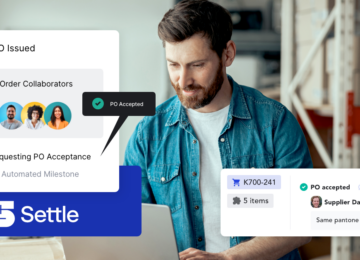Anvyl recently had the pleasure of hosting a webinar alongside a few innovative partners. We were joined by Casey Isaac, Sr. Director of Strategic Sales & Partnerships at Flowspace, Olivia Frere, Director of Brand Strategy at Extensiv, and Fabricio Miranda, CEO and Co-Founder of Flieber for a conversation called “Supply Chain Optimization: Diversifying and Scaling Operations”.
Led by Anvyl’s own Carissa Davis, Senior Client Success Manager, the team delved into the rising complexities impacting the supply chain’s first mile, the biggest challenges facing brands in this pivotal stage, and the key strategies needed to optimize it and take operations to the next level.
In this blog, we dissect the webinar’s key talking points, highlighting our experts’ top advice for optimizing the initial stages of your supply chain with growth and scale in mind. Here’s some areas we’ll hit on:
- What to consider when choosing a fulfillment center
- How to identify when the time is right to scale
- What to look for in a first mile partner
- What a great tech stack looks like
- How to overcome omnichannel complexities
Before we begin, did you know that 73% of businesses are planning to scale into a new channel in the next 6-12 months?
Businesses are increasingly embracing new channels in order to increase their reach, generate more sales opportunities, and grow their revenue. But while expansion has its benefits, it also adds complexity to organizations’ supply chains, especially their first mile.
Pay attention to the key takeaways below to learn how to achieve long-term success with a balanced omnichannel portfolio.
Takeaway #1: 3PLs Are A Great Choice for Distribution
According to Flowspace’s Casey Isaac, one of the most important decisions you’ll make when you scale to omnichannel is choosing your fulfillment method. When doing this, you must ask yourself an important question: Do I want to own and operate fulfillment or work with a Third-Party Logistics (3PL) provider?
Casey says the answer is obvious: 3PLs have more benefits than owning and operating. He broke down these benefits as follows:
- You won’t have any long-term capital investments: You can pay on a transactional basis and only for the services that you’re utilizing on a monthly basis. If you own and operate, it will be very expensive to have more than one location.
- With 3PLs, you can distribute inventory across more than one node: It’s much easier to allocate inventory across multiple locations, meaning you can fulfill orders more efficiently and reduce delivery costs.
- Less stress for managers: You don’t have to manage a warehouse and everything that comes along with it, including labor management in a difficult labor environment, maintenance, liability insurance, etc.
As Casey explained, “You can focus on what you’re good at, which is growing your brand and letting the experts handle your order fulfillment. The only reason it might make sense to own and operate is if you have something that’s super proprietary in your fulfillment model, but otherwise, 3PL is your winner.”
Takeaway #2: Not All 3PLs Are Built the Same
They are a great choice, but there’s a lot to consider when choosing a 3PL partner. Firstly, they must have omnichannel experience. Flowspace’s Casey Isaac says most 3PLs will say they’re omnichannel, but you still need to do your research. Here’s what you should look for in a 3PL partner:
- Direct-to-Consumer (DTC): You need a provider who has experience with pick and pack, and can handle small orders and individual units. They must also have software that easily integrates with DTC channels, like Shopify, Magento, etc.
- Dropshipping: If you’re dropshipping, you want to make sure that they have market share, retail connections, full EDI capabilities, and can pick and pack orders.
- Wholesale: For wholesale, you need a partner that can handle EDI transactions, can generate UCC-128 compliant labels, and has experience with retail compliance and fulfilling bulk shipments to retailers. You also want to make sure they have a large footprint, given you’ll have to hold a lot more inventory if you’re expanding to omnichannel.
Takeaway #3: Location Matters
Fast, affordable shipping is no longer a nice-to-have. Consumers and retailers alike now expect it, much due to the high bar set by Amazon. In order to keep up with expectations as they evolve and increase over time, it’s important to choose a partner with a national footprint.
“They can help you develop a distributed inventory model,” says Casey, “where you’re placing inventory across multiple nodes to create as many efficiencies as possible and are able to deliver really anywhere in the country within two days.”
Extensiv’s Olivia Frere shared Casey’s sentiment, touching on the variances in transportation and labor costs depending on if your inventory is sitting on the east or west coast, or in the middle of the U.S.
“You need to think about that as you start looking at your fulfillment strategy and expanding your network”, she says.
Takeaway #4: There Are 5 Key Things to Consider When Deciding When to Scale
Scaling your operations isn’t just about scaling distribution, says Extensiv’s Olivia Frere. Your operations also include your tech stack and your fulfillment networks. When deciding when to scale these operations, there are 5 things you must consider. These are:
- Inflection Points: “When we talk about inflection points, we’re talking about businesses and brands that are starting to double their volume, whether it be 100 orders to 200 or 500 orders to 1,000,” Olivia explains. “It’s not always about revenue generation. It’s about the transactions.”
- Automation: Businesses experiencing an increase in transactions need a solution that will help them fulfill their orders more quickly. This is why automation is critical for brands starting to scale and grow their business. Olivia recommends brands choose a solution that gives them visibility into the future, providing insight into when they might run out of a product. She also advises they find a system that can automate purchase ordering and tracking.
- Inventory Diversification/Expansion: You also want to look at where you’re shipping your orders, and then consider how you can diversify your inventory accordingly. You want delivery to be as quick as possible, but it needs to be cost efficient, too.
- New Strategic Vendors & Partners: “One thing that becomes much harder as you start expanding your inventory is partners who can help you produce that product quickly,” Olivia admits. You must ensure you’re able to negotiate the right terms with them, that they understand when your peak seasons are, and that you can get your products as quickly as possible.
- Cost: Your goal is to get your products to your customers as quickly as possible. But you also need to make a profit, which is why you must consider the cost efficiency of scaling your operations.
Takeaway #5: AI Is Improving Forecasting, But It’s Not Replacing Inventory Planners
By analyzing historical sales data, seasonality patterns, market trends, and external factors, artificial intelligence is advancing inventory forecasting. But it’s not replacing inventory planners, according to Flieber’s Fabricio Miranda. Rather, AI is a powerful tool that’s helping businesses improve certain aspects of their business, including data processing, forecasting, and inventory management.
Fabricio explains, “AI’s benefits range from very simple advantages, like understanding data better, to more robust benefits like making complex replenishment decisions. At Flieber, we don’t see it as a solution. We see AI as a tool that we embed to support better decision making. This is a small difference, but it makes a huge difference.”
He also highlighted AI’s ability to continuously learn and adapt, incorporating real-time data to refine forecasts and respond to dynamic market conditions, resulting in improved inventory management and cost savings for businesses.
Takeaway #6: You’re Only As Good As Your Tech Stack
To build a scalable supply chain, you need a strong tech stack. A great tech stack enables efficient and automated processes, allowing you to improve operational efficiency and maximize resources as you grow.
As Anvyl’s Carissa Davis says, “It’s really important to make sure that you have the right tech stack, the right tools, and the right partners working with you to ensure that you are taking your business to the next level in a way that’s profitable.
“As you continue to mature and grow, you need better data and better reporting, and you must have the information that you need today so that you set yourself up for success.”
A longstanding reliance on outdated systems and processes is still hurting supply chain teams. In fact, Anvyl’s research found that 67% of businesses still use Excel to manage their inventory. A tool that’s not good enough to keep up with the complexities of scaling your business, according to Flieber’s CEO Fabricio Miranda.
Fabricio explains, “Spreadsheets are an illusion of control. You can change anything, you can create formulas, you can have macros, you can do whatever you want. And you feel like by being in control, you are making better decisions. But this is not the case, especially with complex problems like inventory.”
Instead, supply chain teams need a modern solution that gives them better visibility into their first mile. Anvyl’s intelligent purchase order (PO) management platform empowers these teams to manage the entire PO process with one tool, meaning you don’t have to shuffle between email, spreadsheets, and other tools to keep your purchase orders on track.
We also integrate neatly with Flowspace’s fulfillment management platform, Extensiv’s 3PL and inventory management software, and Flieber’s inventory planning platform, giving supply chain teams greater access to a more robust tech stack.
Watch our webinar with Flowspace, Extensiv, and Flieber here.
To learn how Anvy can help you gain visibility, collaboration, automation, and intelligence into your supply chain’s first mile, book a demo today!



